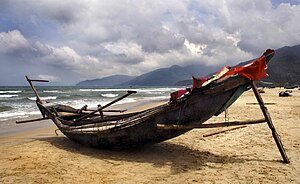Perahu nelayan tradisional
Tampilan


Secara tradisional, beberapa jenis perahu berbeda dipakai sebagai perahu nelayan untuk menangkap ikan di laut, atau danau atau sungai. Saat ini, beberapa perahu nelayan tradisional masih dipakai. Menurut Organisasi Pangan dan Pertanian PBB, pada akhir 2004, armada nelayan dunia terdiri dari sekitar 4 juta kapal, 2.7 juta diantaranya adalah perahu tak berdek (terbuka). Sementara hampir semua kapal berdek memiliki mesin, hanya sepertiga kapal tak berdek yang bertenaga mesin, biasanya dengan mesin di luar badan. 1.8 juta perahu lainnya adalah kerajinan tradisional dari berbagai jenis, yang dioperasikan oleh layar dan kayuh.[1]
Catatan
[sunting | sunting sumber]- ^ FAO (2007) The status of the fishing fleet Diarsipkan 2019-02-18 di Wayback Machine. State of World Fisheries and Aquaculture, Food and Agriculture Organization of the United Nations, Rome. ISBN 978-92-5-105568-7
Referensi
[sunting | sunting sumber]- Chapelle, Howard L. (1951) American Small Sailing Craft WW Norton Company, New York, ISBN 0-393-03143-8
- Fagan, Brian (2008) The Great Warming. Chapter 10: Bucking the trades Bloomsbury Press. ISBN 978-1-59691-392-9
- FAO: CWP Handbook of Fishery Statistical Standards: Section L: Fishery Fleet
- FAO (2007) The status of the fishing fleet Diarsipkan 2019-02-18 di Wayback Machine. State of World Fisheries and Aquaculture, Food and Agriculture Organization of the United Nations, Rome. ISBN 978-92-5-105568-7
- Forman, Shepard (1970) The raft fishermen: Tradition & change in the Brazilian peasant economy, Indiana University Press for International Affairs Center. ISBN 0-253-39201-2
- Gardner, John (1987) The Dory Book. Mystic Seaport Museum, Mystic Connecticut. ISBN 0-913372-44-7
- Johnstone, Paul (1889) The Sea-Craft of Prehistory, Routledge. ISBN 978-0-415-02635-2
- McGrail, Sean (2004). Boats of the World: From the Stone Age to Medieval Times. USA: Oxford University Press. ISBN 0-19-927186-0.
- Vries, J. de, and Woude, A. van der (1997), The First Modern Economy. Success, Failure, and Perseverance of the Dutch Economy, 1500-1815, Cambridge University Press, ISBN 978-0-521-57825-7
Reading
[sunting | sunting sumber]- Adney ET, Chappelle HI and McPhee J (2007) Bark Canoes and Skin Boats of North America Skyhorse Publishing. ISBN 1-60239-071-1
- Gerr, Dave (1995) The Nature of Boats: Insights and Esoterica for the Nautically Obsessed McGraw-Hill Professional. ISBN 978-0-07-024233-3
- Smylie, Michael (1999) Traditional Fishing Boats of Britain & Ireland: Design, History and Evolution. Adlard Coles Nautical. ISBN 978-1-84037-035-5
- Smylie, Mike (2013) Traditional Fishing Boats of Europe Amberley Publishing Limited. ISBN 9781445614342.
- Traung, Jan-Olaf (1960) Fishing Boats of the World 2 Fishing News (Books) Ltd. Download PDF (99MB)
- Traung, Jan-Olaf (1967) Fishing Boats of the World 3 Kiefer Press. ISBN 978-1-4437-6711-8. Download PDF (56MB)
- Vigor, John (2004) The Practical Encyclopedia of Boating: An A-Z Compendium of Seamanship, Boat Maintenance, Navigation, and Nautical Wisdom McGraw-Hill Professional. ISBN 978-0-07-137885-7
- Woodman, Richard (1998) The History of the Ship: The Comprehensive Story of Seafaring from the Earliest Times to the Present Day, Lyons Press. ISBN 978-1-55821-681-5
Pranala luar
[sunting | sunting sumber]Wikimedia Commons memiliki media mengenai Fishing boats.
- The Uros People at GlobalAmity.net
- Video tour of Uros floating fishing villages
- Uros Indian Culture - Home
- Floating islands on Google Maps
- Trujillo, The Golden Steeds of Huanchaco
- Indigenous boats: Small craft outside the Western tradition
- A history of shipbuilding in Newfoundland Diarsipkan 2008-10-17 di Wayback Machine.
- Jangadeiros, the fishermen in the northeastern Brazil
- Indigenous sails Diarsipkan 2018-08-31 di Wayback Machine.
